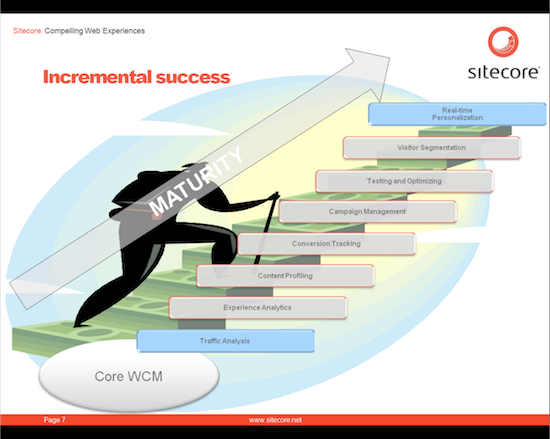Are content managers ready for personalization?
I have been catching up on product demos recently and have seen some really elegant functionality for marketers. Several products have introduced modules that allow CMS users to plan, implement, and measure multivariate testing, search engine optimization, and personalization without the continued support of a developer. A developer has to put the tools in place but, after that, the CMS user can fully control the behavior of the site and optimize its business impact.
It is easy to get excited by this functionality. But then you think of the difficulty your average organization has with even the basic aspects of content production and you wonder if they ready for these tools. How can you do an A/B test if getting someone to write option "A" is a struggle and option "B" would be a miracle? Of course, not all companies suffer from these issues. The more sophisticated publishers and eCommerce companies have been doing these advanced site management activities even when the technology stood in their way, much less facilitated them. But your average marketing site is still in the dark ages when it comes to managing content.
Will your average marketing group be able to leverage this functionality? Or will it be yet another unused feature that clutters the user interface? My hope is that once contributors and site managers start to experiment and see results, they will rapidly evolve to be more committed and proactive in the same way social media participants started to embrace tagging when they saw their work start to surface in more prominent places. A tight and accurate feedback loop is important in any learning process so maybe access to testing and metrics has been the missing feature rather than usability-oriented functionality like in-context editing. It is probably more effective to make a task interesting and rewarding than to make that uninteresting work easier to do. The former strategy will cause a user to overcome any obstacle he is faced with. In the latter strategy, there will always be some excuse not to do the work. I touched on this idea in an earlier post called "What your intranet needs is a publisher!"
That is not to say that all you need to do is drop in personalization functionality one day and your organization will immediately change. I have seen many organizations fail with this approach because they didn't have the content to support it. I saw a slide from a Sitecore (below, click for a larger image) demonstration that shows a gradual maturity process that begins with understanding your users and your content and ending with real time personalization.
I very much agree with the model but I think that the trick to success is being able to see real results at every step of the way. Most organizations will not have the commitment to sustain a continuous effort through long periods of no results. Results are easy to felt from the conversion tracking step onward. Getting to that point, however, will require organizations to aggressively push through traffic analysis, experience analysis, and content profiling. Perhaps there is room to get some intermediate outcomes along the way that can keep an organization hungry for more. These outcomes can't just be in the form of a spreadsheet that is out of date by the time that it is presented. There needs to be some tangible business impact like being able to make a small change to the website that yields some measurable result. If this is not possible, the best one can do is time-box this period of no feedback and have faith that the results will be worth that fixed investment.
They are just coming on the market now but I am really looking forward to seeing the organizational response to these marketing tools. The early adopters will certainly benefit from the functionality because, by being early adopters, they have already shown their commitment to improvement. It will be really interesting to see examples of this functionality transforming mainstream organizations that have struggled in the past.
